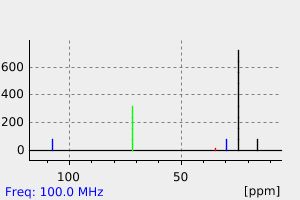(E)-5-methyl-2-tert-butyl-1,3-dioxane | 34067-11-3
中文名称
——
中文别名
——
英文名称
(E)-5-methyl-2-tert-butyl-1,3-dioxane
英文别名
——
CAS
34067-11-3
化学式
C9H18O2
mdl
——
分子量
158.241
InChiKey
JKFYNAIRKZYRNO-OCAPTIKFSA-N
BEILSTEIN
——
EINECS
——
-
物化性质
-
计算性质
-
ADMET
-
安全信息
-
SDS
-
制备方法与用途
-
上下游信息
-
文献信息
-
表征谱图
-
同类化合物
-
相关功能分类
-
相关结构分类
计算性质
-
辛醇/水分配系数(LogP):2.04
-
重原子数:11.0
-
可旋转键数:0.0
-
环数:1.0
-
sp3杂化的碳原子比例:1.0
-
拓扑面积:18.46
-
氢给体数:0.0
-
氢受体数:2.0
上下游信息
-
上游原料
中文名称 英文名称 CAS号 化学式 分子量 —— 2-tert-butyl-5-methylene-1,3-dioxane 26170-12-7 C9H16O2 156.225
反应信息
-
作为产物:描述:2-tert-butyl-5-methylene-1,3-dioxane 在 叔丁基过氧化氢 、 di(tert-butyl) trioxide 、 一水合肼 作用下, 以 叔丁醇 为溶剂, 反应 24.0h, 生成 (E)-5-methyl-2-tert-butyl-1,3-dioxane参考文献:名称:Origin of stereofacial selectivity in electrophilic additions to methylenecyclohexanes and methylenedioxanes. A theoretical and experimental study摘要:对亚甲基环己烷和 5-亚甲基-1,3-二氧六环体系进行的加成反应研究和 ab initio 计算表明,两个电子因素有助于环氧化和二亚胺还原的立体选择性。这两个因素分别是:HOMO 相对于双键两个面的空间各向异性(这是两个分子共有的),这可能是表现出的整体轴向立体选择性的原因;由氧原子引起的亚甲基二氧杂环己烷静电势场的类似各向异性;这也有利于可极化亲电物种从轴向进行攻击。HOMO 的各向异性源于周面 β C-H σ 键和对立的 β C-O 或 C-C σ 键对 HOMO 的贡献存在重要的拓扑差异。环己烷和二氧杂环烷体系的催化还原过程具有赤道面选择性,似乎主要受立体效应的影响。DOI:10.1039/a800999f
文献信息
-
Ishiyama, Jun-ichi; Senda, Yasuhisa; Imaizumi, Shin, Journal of the Chemical Society. Perkin transactions II, 1982, p. 71 - 76作者:Ishiyama, Jun-ichi、Senda, Yasuhisa、Imaizumi, ShinDOI:——日期:——
-
Cai, Jiaqiang; Davies, Alwyn G.; Schiesser, Carl H., Journal of the Chemical Society. Perkin transactions II, 1994, # 6, p. 1151 - 1156作者:Cai, Jiaqiang、Davies, Alwyn G.、Schiesser, Carl H.DOI:——日期:——
表征谱图
-
氢谱1HNMR
-
质谱MS
-
碳谱13CNMR
-
红外IR
-
拉曼Raman
-
峰位数据
-
峰位匹配
-
表征信息
同类化合物
(2S,4aR,5S,8R,8aR)-8-乙基-4a,5-二羟基-六氢-2H-2,5-环氧色素-4(3H)-酮
顺式-5-甲氧基-2-苯基-1,3-二恶烷
阿斯利多
锗(II)氯化二噁烷络合物
试剂5-Methyl-5-propargyloxycarbonyl-1,3-dioxane-2-one
螺二醇
螺[环丙烷-1,7'-[2,3]二氧杂双环[2.2.1]庚烷]
螺[3,6-二氧杂双环[3.1.0]己烷-2,4'-咪唑烷]
薰衣草恶烷
苯乙醛 1,3-丙烷二基缩醛
脱水莫诺苷元
硫脲与2,4,8,10-四氧杂螺[5.5]十一烷-3,9-丙二胺和缩水甘油丁醚的反应产物
硝溴生
盐酸曲阿霉素
盐酸大观霉素
盐酸1,4-二恶烷
甲基 2,3-脱水-beta-D-呋喃核糖苷
甘油缩甲醛
溴化[5-(羟甲基)-2-苯基-1,3-二噁烷-5-基]-N,N,N-三甲基甲铵
溴[4-(1,3-二恶烷-2-基)苯基]镁
溴[3-(1,3-二恶烷-2-基)苯基]镁
溴[2-(1,3-二恶烷-2-基)苯基]镁
溴-1,4-二氧六环复合物
氯甲基聚苯乙烯
敌噁磷
戊氧氯醛
对二恶烷-2,6-二甲醇
奇烯醇霉素
大观霉素
埃玛菌素
四氢-2-呋喃基甲基2-氯苯甲酸酯
吡啶,2-(1,3-二噁烷-2-基)-
反式-5-溴-4-苯基-[1,3]二恶烷
反式-5-溴-4-苯基-[1,3]二恶烷
反式-5-氯-2-苯基-1,3-二恶烷
反式-5-乙氧基-2-异丙基-1,3-二恶烷
反式-2,5-双-(羟甲基)-1,4-二恶烷
双(4-乙基亚苯基)山梨醇
六氢[1,4]二恶英并[2,3-b]-1,4-二恶英
六氢-2,4,4,7-四甲基-4H-1,3-苯并二氧杂环己
全氟(2-氧代-3,6-二甲基-1,4-二恶烷)
亚苄基-2,2-双(氧基甲基)丙酸
二苯并[b,e][1,4]二噁英,4a,5a,9a,10a-四氢-,溴化氯化(1:2:6)
二苯并[b,e][1,4]二噁英,4a,5a,9a,10a-四氢-,溴化氯化(1:2:5)
二聚丁醇醛
二甲基二恶烷
二甲基2,4:3,5-二-O-亚甲基-D-葡萄糖二酸
二甲基2,4,8,10-四氧杂螺[5.5]十一烷-3,9-二羧酸酯
二甲基-1,4-二恶烷
二甘醇酐







